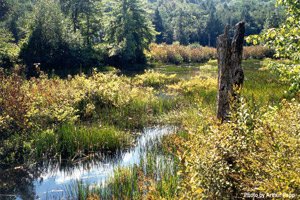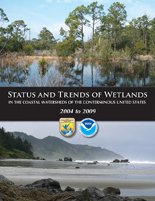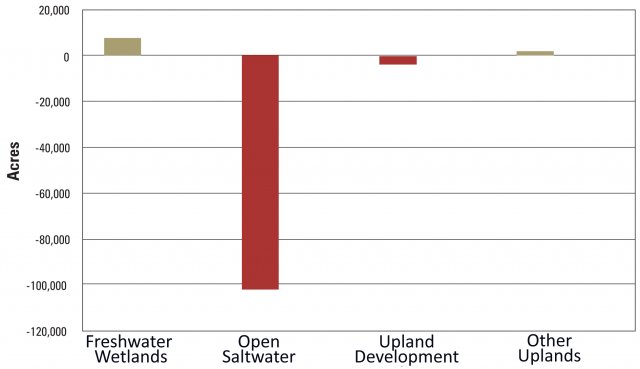About Coastal Wetlands
Despite their environmental and economic importance, coastal wetlands (wetlands located in coastal watersheds) in the eastern United States are being lost at twice the rate they are being restored. More focused protection strategies are required to reverse this trend.
- What are "coastal wetlands"?
- Why are coastal wetlands important?
- What is the rate of coastal wetlands loss?
- Why are coastal wetlands being lost?
What are coastal wetlands?
Coastal wetlands include saltwater and freshwater wetlands located within coastal watersheds — specifically, USGS 8-digit hydrologic unit watersheds which drain into the Atlantic Ocean, Pacific Ocean, or Gulf of America.

Wetland types found in coastal watersheds include salt marshes, bottomland hardwood swamps, fresh marshes, mangrove swamps, and shrubby depressions known in the southeast United States as "pocosins." Coastal wetlands cover about 40 million acres and make up 38 percent of the total wetland acreage in the conterminous United States. Eighty-one percent of coastal wetlands in the conterminous United States are located in the southeast.
The diagram to the right illustrates the range of wetlands which can be found in a coastal watershed. These wetlands can be tidal or non-tidal, and freshwater or saltwater.

As seen on the map (above), coastal watersheds can extend many miles inland from the coast. The extent and condition of wetlands within a coastal watershed is both dependent on and influences the health of the surrounding watershed. Wetlands in coastal watersheds are experiencing disproportionate losses compared to wetlands in the rest of the country, making them particularly important areas for protection.
Why are coastal wetlands important?
Coastal habitats provide ecosystem services essential to people and the environment. These services are valued at billions of dollars.1
Services provided by coastal wetlands include:
- Flood Protection: Coastal wetlands protect upland areas, including valuable residential and commercial property, from flooding due to sea level rise and storms.2
- Erosion Control: Coastal wetlands can prevent coastline erosion due to their ability to absorb the energy created by ocean currents which would otherwise degrade a shoreline and associated development.3
- Wildlife Food & Habitat: Coastal wetlands provide habitat for many federally threatened and endangered species, including Whooping Crane, Louisiana Black Bear and Florida Panther.4 Two of North America's migratory bird flyways pass over the Pacific and Atlantic coasts, where coastal wetlands provide temporary habitat to waterfowl and shorebirds.
- Commercial Fisheries: Over 50 percent of commercial fish and shellfish species in the Southeastern United States rely on coastal wetlands. 5
- Water Quality: Wetlands filter chemicals and sediment out of water before it is discharged into the ocean.3
- Recreation: Recreational opportunities in coastal wetlands include canoeing, kayaking, wildlife viewing and photography, recreational fishing and hunting.
- Carbon Sequestration: Certain coastal wetland ecosystems (such as salt marshes and mangroves) can sequester and store large amounts of carbon due to their rapid growth rates and slow decomposition rates.6


Coastal watersheds contain both freshwater (left) and saltwater (right) wetlands.
What is the rate of coastal wetland loss?

In the coastal watersheds of the Atlantic, Pacific, the Gulf of America and the Great Lakes, wetlands were lost at an average rate of about 80,000 acres per year between 2004 and 2009.
Coastal wetland acreage trends are documented in the Status and Trends of Wetlands in the Coastal Watersheds of the Conterminous United States, 1998 to 2004 (PDF)(36 pp, 8.83 MB, About PDF) report and a subsequent report Status and Trends of Wetlands in the Coastal Watersheds of the Conterminous United States, 2004 to 2009 (PDF)(58 pp, 14.93 MB, About PDF) by the U.S. Fish & Wildlife Service (FWS) and the National Oceanic and Atmospheric Administration's National Marine Fisheries Service. This analysis concluded that more than 80,000 acres of coastal wetlands are being lost on average each year, up from about 59,000 acres lost per year in the previous study covering 1998 to 2004. A majority of this loss occurred in freshwater wetlands.
Why are coastal wetlands being lost?
Coastal wetland losses occur as a result of both human activity and natural processes.
Human Activity: Human activities which may lead to losses of coastal wetlands include urban and rural development, agriculture, and silviculture. These land use changes can also indirectly impact nearby wetlands by altering hydrology through increased runoff or water withdrawals in the watershed. Most of this loss occurs in freshwater wetlands. Over half of the U.S. population lives in coastal counties, intensifying the stress on coastal wetlands relative to inland areas.7
Natural Processes: Coastal wetlands, especially estuarine and marine wetlands, are naturally altered by high energy events such as erosion and inundation from sea level rise and storms. The impacts of these processes may be magnified by climate change and shoreline armoring. Estuarine wetlands typically protect the coastline from erosion and flooding, but if sea level increases and development prevents inland migration of wetlands, more wetlands will be converted to open water.
Freshwater Wetlands Losses and Gains

Post-loss Land Cover Type
Saltwater Wetlands Losses and Gains

Post-loss Land Cover Type
Wetland losses and gains and the resulting changes in land cover between 2004 and 2009 in freshwater (top) and saltwater (bottom) wetlands. Loss or conversion occurred in 265,723 acres of freshwater wetlands and 94,999 acres of saltwater wetlands. Based on information from Status & Trends of Wetlands in the Coastal Watersheds of the Conterminous United States 2004 to 2009.
References
1 Pendleton, L. 2008. The Economic and Market Value of Coasts and Estuaries: What's at Stake? Restore America's Estuaries, Arlington, VA, 182 pp.
2 Costanza, R., O. Pérez-Maqueo, ML Martinez, P Sutton, SJ Anderson, K Mulder. 2008. The value of coastal wetlands for hurricane protection. Ambio 37(4): 241-248
3 Carter, V. 1997. Technical Aspects of Wetlands: Wetland Hydrology, Water Quality, and Associated Functions. United States Geological Survey Water Supply Paper 2425.
4 FWS. Endangered Species.
5 Martin, DM, T Morton, T Dobrzynski, & B. Valentine. 1996. Estuaries on the Edge: The Vital Link Between Land and Sea. A Report by American Oceans Campaign.
6 NOAA National Marine Fisheries Service. Coastal Blue Carbon
7 NOAA National Ocean Service. 2004.
Population Trends along the Coastal United States 1980 to 2008 (pdf)
